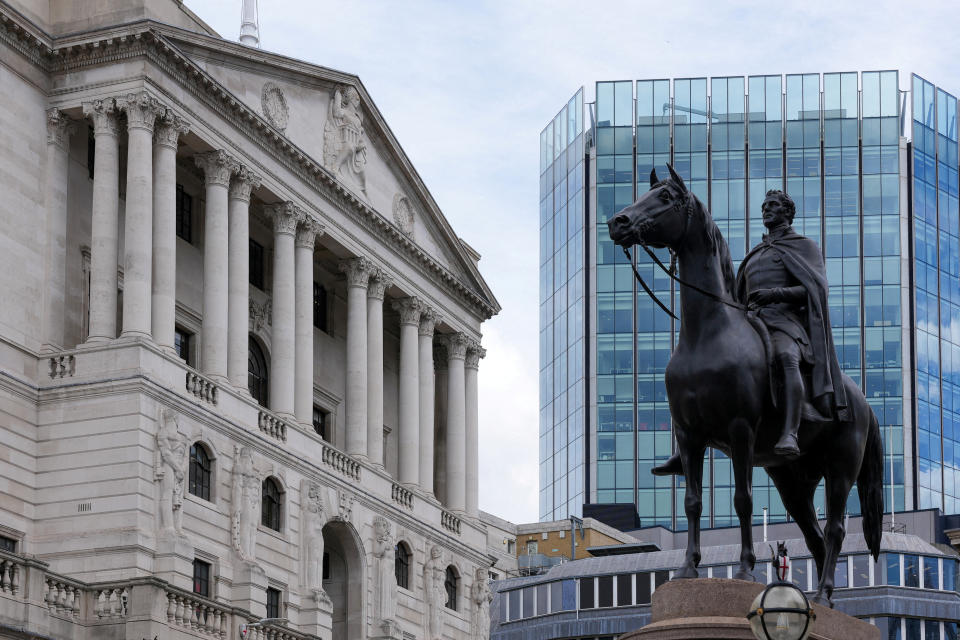

UK households have stayed resilient in the face of high interest rates but some businesses are likely to struggle with higher borrowing costs, according to the Bank of England.
The BoE has left interest rates unchanged at a 16-year high of 5.25% for the fifth time in a row.
“So far UK borrowers have been resilient to the impact of higher interest rates,” the BoE’s Financial Policy Committee said in a quarterly update.
The figures showed a rising trend of mortgages with 30-year terms – which now accounted for almost half (40%) of new mortgages, as buyers spread their home loans over a longer period to be able to make bills more affordable.
Read more: Trending tickers: Trump Media, Tesla, Bitcoin and DS Smith
The BoE said this has made the loans more affordable for many borrowers, but it could also affect future borrower and lender resilience if people are more at risk of defaulting on their repayments.
About 45% of fixed-rate mortgage holders are still facing higher monthly repayments when they reprice their mortgage by the end of 2026.
The level of mortgage arrears had increased slightly and is expected to rise further, but remains low by historical standards.
UK businesses have also managed to cope with higher interest rates but the central bank warned that small businesses will struggle.
“We expect most UK businesses to continue to be resilient to higher interest rates and weak growth. But some are likely to struggle with higher borrowing costs – in particular, those firms in parts of the economy most exposed to a slower growth, or with a large amount of debt,” it said.
Corporate insolvencies in England and Wales in February were 17% higher than a year earlier and 50% above their level four years ago, just before the COVID-19 pandemic struck.
Read more: FTSE 100 LIVE: European stocks muted as traders take a breath ahead of Easter weekend
The BoE has been trying to bring down inflation to its 2% target without harming the economy but high interest rates have raised borrowing costs for mortgage holders who are paying more each month to the bank.
Market analysts argue that with consistent falls in the growth rate of inflation, the Bank’s rate-setting Monetary Policy Committee (MPC) is running out of reasons not to cut rates.
However, rate-setter Catherine Mann has warned that financial markets are expecting too many interest rate cuts this year and that the UK central bank is unlikely to move before the US Federal Reserve.
Mann told Bloomberg TV on Tuesday: “They’re pricing in too many cuts – that would be my personal view – and so in some sense, I don’t have to cut because the market already is.”
“Wage dynamics in the UK are stronger and more persistent than the wage dynamics in either the US or the euro area,” she said.
“Underlying services dynamics are also stickier more persistent than either the US or the euro area. So on that basis, it’s hard to argue that the BoE would be ahead of the other two regions, particularly the US.”
Both the European Central Bank (ECB) and the US Federal Reserve (Fed) have kept rates unchanged this month.
Nomura Bank noted that central banks might be suffering from the “fear of going first”, with the ECB and BoE circling wagons until the US Federal Reserve cuts rates. However, they argue that both central banks can cut rates independently of the Fed.
Read more: UK inflation falls to two-year low of 3.4%
“Market pricing for the ECB, and to a lesser extent the BoE, has been largely driven by Fed rate expectations. Market participants believe other central banks have a ‘fear of going first’, but we think the macroeconomic cycles in the US and Europe are decoupling, which justifies the ECB and BoE going it alone and cutting rates independently of the Fed,” analysts at the bank said.
Traders widely expect the first rate cut to take place in the summer, either in June or August.
Andrew Bailey, the Bank’s governor, has signalled that rate cuts will be “in play” at forthcoming policy meetings.
Watch: Governor Andrew Bailey explains decision to hold interest rates at 5.25%
Download the Yahoo Finance app, available for Apple and Android





